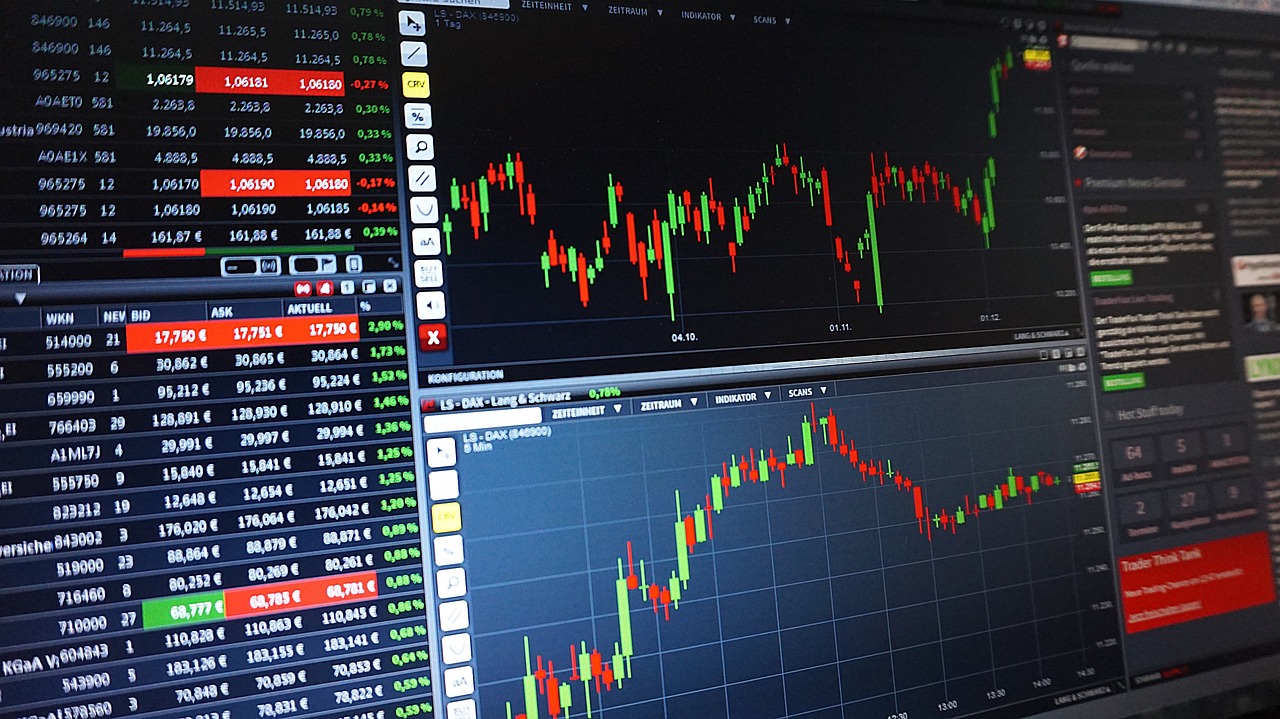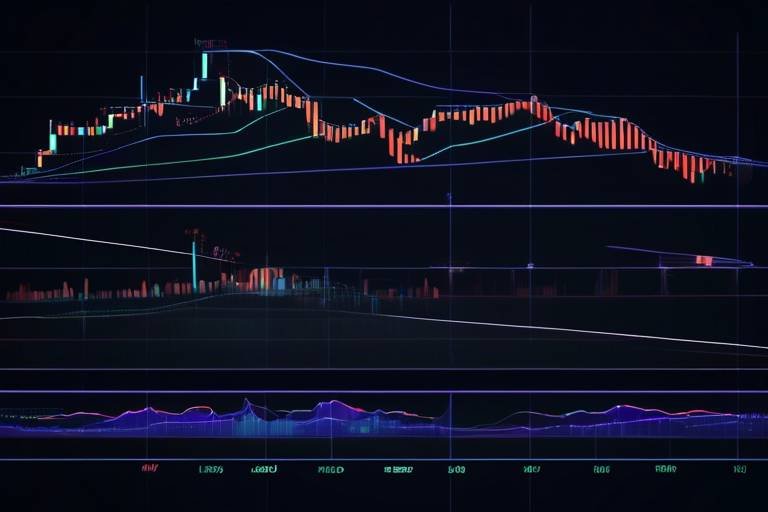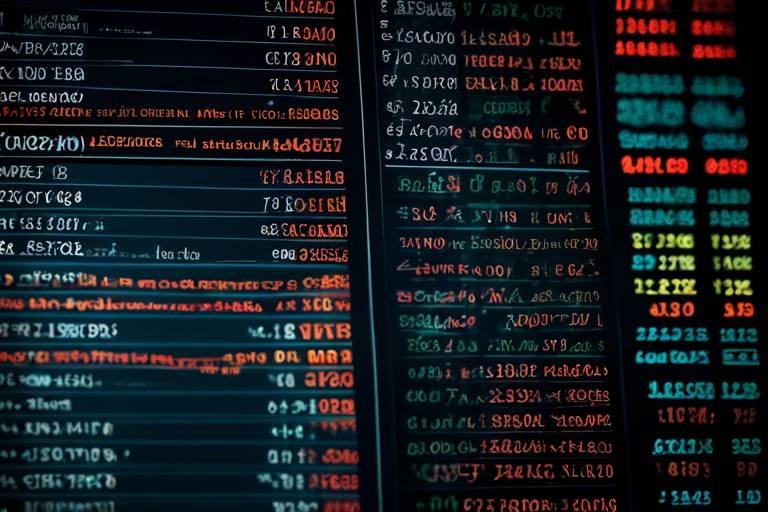How to Optimize Your Technical Analysis Skills
In the fast-paced world of trading, having a solid grasp of technical analysis can be your secret weapon. Imagine standing at the edge of a vast ocean, each wave a potential trading opportunity. With the right skills, you can ride those waves instead of being swept away. This article explores various strategies and techniques to enhance your technical analysis abilities, helping you make informed trading decisions and improve your overall market performance.
So, what exactly is technical analysis? At its core, it's the study of past market data, primarily price and volume, to forecast future price movements. Think of it as a detective piecing together clues to solve a mystery. Unlike fundamental analysis, which focuses on a company's financial health and economic factors, technical analysis is all about the numbers and patterns that emerge from the price charts. By understanding these patterns, you can make more informed trading decisions, setting the foundation for optimizing your skills in this area.
When diving into technical analysis, you'll encounter a variety of essential indicators and tools that can help you navigate the market. Some of the most popular include:
- Moving Averages: These smooth out price data to identify trends over a specific period.
- Relative Strength Index (RSI): This momentum oscillator measures the speed and change of price movements to identify overbought or oversold conditions.
Using these tools effectively can help you identify trends and make informed decisions in the market. Imagine having a map while exploring uncharted territory; these indicators serve as your compass, guiding you towards potential opportunities.
Chart patterns are like the language of the market, telling you stories about potential future movements. Common patterns include:
- Head and Shoulders: This pattern often signals a reversal trend.
- Flags: These indicate a continuation of the current trend.
- Triangles: These can signal either a continuation or reversal, depending on the breakout direction.
By familiarizing yourself with these patterns, you can better anticipate market movements and make strategic trading choices. It’s like learning to read the stars; once you know how, the universe (or market) becomes much clearer.
Understanding support and resistance levels is crucial in trading. Support levels are where the price tends to stop falling and may bounce back up, while resistance levels are where the price tends to stop rising and may fall back down. Identifying these levels can enhance your market analysis and decision-making. Think of them as the floor and ceiling of a room; knowing where they are can help you navigate the space effectively.
Volume is another key aspect of technical analysis. It tells you how much of a particular asset is being traded over a specific period. High volume during a price increase can confirm a trend, while low volume may suggest a lack of conviction. Understanding volume can provide deeper insight into market dynamics and trader behavior, much like understanding the crowd's mood at a concert; it can tell you whether the energy is high or low.
The timeframe you choose for your analysis can significantly impact your trading strategies. Whether you're a day trader looking for quick profits or a swing trader aiming for longer-term gains, adapting your analysis to fit your style is essential. Different timeframes can reveal different trends, much like viewing a landscape from various heights; each perspective offers unique insights.
Even the most seasoned traders can stumble into pitfalls. Common mistakes include:
- Over-reliance on Indicators: While indicators are helpful, they shouldn't be your only tool.
- Ignoring Market Context: Always consider the broader market environment when making decisions.
By identifying and avoiding these mistakes, you can refine your analysis for better outcomes. It’s like learning to ride a bike; you’ll inevitably wobble, but with practice, you’ll find your balance.
In the world of trading, nothing stays the same for long. The importance of ongoing education and adaptation cannot be overstated. Markets evolve, and so should your strategies. Staying updated with market trends and evolving strategies will ensure consistent improvement. Think of it as tending to a garden; regular care and attention yield the best results.
Finally, how do you apply your technical analysis skills in real trading scenarios? Backtesting strategies and developing a personalized trading plan are essential steps. Backtesting allows you to see how your strategies would have performed in the past, providing valuable insights into their potential effectiveness. A personalized trading plan acts as your roadmap, guiding you through the ups and downs of trading.
1. What is the best indicator for technical analysis?
There isn't a one-size-fits-all answer, as it depends on your trading style. However, moving averages and RSI are popular choices among traders.
2. How can I improve my technical analysis skills?
Continuous learning through books, online courses, and practice through backtesting can significantly enhance your skills.
3. What is the difference between support and resistance?
Support is a price level where buying interest is strong enough to overcome selling pressure, while resistance is a price level where selling interest is strong enough to overcome buying pressure.
By mastering your technical analysis skills, you can navigate the trading landscape with confidence and precision.

Understanding Technical Analysis
Technical analysis is a powerful tool in the world of trading that allows investors to make informed decisions based on historical price movements and trading volumes. Unlike fundamental analysis, which evaluates a company's financial health and economic factors, technical analysis focuses solely on price patterns and market behavior. This approach can be likened to a detective analyzing clues left behind at a crime scene — it’s all about piecing together the story that the market is telling through its price action.
The importance of technical analysis cannot be overstated. It serves as a roadmap for traders, guiding them through the often tumultuous waters of the financial markets. By understanding price movements and market trends, traders can identify potential entry and exit points, manage risk more effectively, and ultimately enhance their profitability. Just imagine trying to navigate a ship without a compass; technical analysis is that compass, helping you steer clear of dangerous waters and towards profitable opportunities.
At its core, technical analysis is built on the idea that all market information is reflected in the price. This means that everything from economic news to trader sentiment can influence price movements. Therefore, traders who master technical analysis can gain a significant edge over those who rely solely on fundamental data. By analyzing charts and indicators, traders can make predictions about future price movements based on past behavior.
To become proficient in technical analysis, one must grasp several key concepts, including:
- Price Action: Understanding how prices move over time is crucial. This includes recognizing trends, reversals, and consolidations.
- Market Sentiment: Gauging the mood of the market can provide insights into potential price movements. Are traders feeling bullish or bearish?
- Volume Analysis: Examining trading volume can confirm trends and provide clues about market strength or weakness.
In summary, technical analysis is an essential skill for traders looking to navigate the complexities of the financial markets. By understanding price movements, market sentiment, and volume, traders can enhance their decision-making process and improve their chances of success. As you embark on your journey to optimize your technical analysis skills, remember that practice and continuous learning are key. The more you immerse yourself in the charts, the better you will become at interpreting the signals they provide.

Key Indicators and Tools
When it comes to mastering technical analysis, understanding the is crucial. These indicators serve as your compass, guiding you through the often turbulent waters of financial markets. They help you gauge market sentiment, identify trends, and make informed trading decisions. Think of them as your toolkit; just as a carpenter wouldn’t build a house without the right tools, you shouldn’t dive into trading without a solid grasp of these essential indicators.
One of the most widely used indicators in technical analysis is the Moving Average (MA). This tool smooths out price data to help traders identify the direction of the trend over a specific period. For instance, a simple moving average (SMA) calculates the average price over a set number of days, providing a clear picture of the market's direction. Traders often look for crossovers between short-term and long-term moving averages as potential buy or sell signals.
Another vital indicator is the Relative Strength Index (RSI). This momentum oscillator measures the speed and change of price movements, helping traders determine whether a market is overbought or oversold. The RSI ranges from 0 to 100, with values above 70 indicating overbought conditions and those below 30 suggesting oversold conditions. Understanding how to interpret the RSI can significantly enhance your trading strategy.
Moreover, Volume is a critical component of technical analysis that cannot be overlooked. Volume indicates the number of shares or contracts traded in a security or market during a given period. High volume often confirms the strength of a price move. For example, if a stock price rises significantly on high volume, it suggests strong buying interest, which can be a bullish signal. Conversely, if a price increase occurs on low volume, it may indicate a lack of conviction in the move.
To effectively utilize these indicators, it’s essential to understand how they interact with one another. For instance, combining the RSI with moving averages can provide a more robust trading signal. If the RSI indicates an overbought condition while the price is above the moving average, it might be wise to consider selling or tightening your stop-loss. This interplay of indicators allows traders to create a more nuanced view of the market.
In addition to these indicators, traders often rely on chart patterns to enhance their analysis. Recognizing patterns like head and shoulders, flags, and triangles can provide insights into potential future price movements. These patterns often indicate a continuation or reversal of trends, making them invaluable for strategic trading decisions.
Ultimately, the key to successful technical analysis lies in understanding how to use these indicators and tools effectively. It’s not just about relying on one or two indicators; it’s about creating a comprehensive strategy that incorporates multiple tools to gain a clearer picture of market dynamics. By honing your skills in these areas, you can significantly improve your trading outcomes and navigate the markets with greater confidence.
- What is the best indicator for beginners in technical analysis? - Many beginners find the Moving Average to be a straightforward and effective tool for identifying trends.
- How can I combine different indicators? - Use multiple indicators to confirm signals; for example, combine RSI with moving averages for a more robust analysis.
- Is it necessary to use all indicators? - No, it’s essential to find a few that work well for your trading style and focus on mastering them.

Chart Patterns
When it comes to technical analysis, understanding is like having a secret decoder ring for the market. These patterns are visual representations of price movements that can signal potential market directions. Think of them as the road signs of trading—each one offers clues about where the market might be headed next. Whether you're a seasoned trader or just starting out, recognizing these patterns can significantly enhance your decision-making process.
Some of the most common chart patterns include the head and shoulders, flags, and triangles. Each pattern tells a story about market sentiment and potential price action. For instance, the head and shoulders pattern often indicates a reversal in trend, suggesting that the market may be shifting from bullish to bearish. On the other hand, flags and triangles typically signify continuation patterns, hinting that the current trend is likely to persist.
To better illustrate these patterns, let’s take a closer look at them in the table below:
| Pattern | Description | Market Signal |
|---|---|---|
| Head and Shoulders | A reversal pattern that indicates a change in trend. | Bearish (from bullish to bearish) |
| Inverse Head and Shoulders | Similar to the head and shoulders but signals a bullish reversal. | Bullish (from bearish to bullish) |
| Flags | Short-term continuation patterns that resemble a flag on a pole. | Continuation of the current trend |
| Triangles | Consolidation patterns that can break out in either direction. | Continuation or reversal, depending on breakout direction |
Recognizing these patterns is crucial, but it's equally important to understand the context in which they appear. A pattern seen in a strong uptrend may have different implications than the same pattern in a downtrend. This is where the concept of market context comes into play. Always consider the overall trend and other indicators before making a trading decision based solely on chart patterns.
In addition to identifying these patterns, traders should also be aware of the volume accompanying them. Volume can confirm the strength of a pattern; for example, a breakout from a triangle pattern accompanied by high volume is generally more reliable than one with low volume. This highlights the importance of not just looking at the patterns but also analyzing the underlying market dynamics.
In summary, mastering chart patterns is a vital component of technical analysis. By learning to recognize these patterns and understanding their implications, you can make more informed trading decisions. Remember, the market is like a puzzle, and each chart pattern is a piece that helps you see the bigger picture. So, keep your eyes peeled for these signs—they might just lead you to your next big trading opportunity!
Q: What is the significance of chart patterns in trading?
A: Chart patterns help traders identify potential market movements and trends, allowing them to make more informed trading decisions.
Q: How can I practice recognizing chart patterns?
A: You can use historical charts to practice identifying patterns and simulate trades based on those patterns to enhance your skills.
Q: Are chart patterns always reliable?
A: While chart patterns can provide valuable insights, they are not foolproof. Always consider other indicators and market context before making trading decisions.

Support and Resistance Levels
When diving into the world of technical analysis, understanding is akin to having a reliable compass in uncharted waters. These levels are crucial for traders as they indicate where the price of an asset is likely to pause or reverse. Think of support as the floor that prevents prices from falling further, while resistance acts as a ceiling that caps price increases. Identifying these levels can significantly enhance your trading decisions and boost your confidence in the market.
Support levels are price points where buying interest is strong enough to overcome selling pressure. Imagine a bouncing ball hitting the ground; it’s likely to bounce back up when it hits the support level. Conversely, resistance levels are where selling interest outweighs buying, leading to price declines. Picture a balloon trying to rise; it will struggle to break through a ceiling. Recognizing these dynamics allows traders to anticipate potential price movements and make informed decisions.
To effectively identify support and resistance levels, traders often look at historical price data and employ various methods, including:
- Historical Price Levels: Previous highs and lows often serve as strong indicators of future resistance and support.
- Trend Lines: Drawing trend lines can help visualize these levels, making it easier to spot potential reversals.
- Moving Averages: These can act as dynamic support or resistance, adapting as new price data comes in.
It's also essential to consider the psychological aspects of support and resistance. Traders often place orders around these levels, creating a self-fulfilling prophecy. For example, if many traders believe that a stock's price will not fall below $50, they might buy at that level, leading to an actual price bounce. This collective behavior reinforces the importance of these levels in market dynamics.
Moreover, the strength of support and resistance can vary. A level that has been tested multiple times without being broken tends to be seen as more significant. This is where the concept of “breakouts” comes into play. When the price finally breaks through a resistance level, it can lead to a surge in buying interest, while breaking below a support level may trigger panic selling. Understanding these nuances allows traders to position themselves advantageously.
In summary, mastering support and resistance levels is fundamental for any trader aiming to enhance their technical analysis skills. By integrating these concepts into your trading strategy, you can better navigate the complexities of the market and make more informed, confident decisions. So, the next time you analyze a chart, remember to pay close attention to these critical levels; they might just be the key to unlocking your trading potential.

Volume Analysis
When diving into the world of technical analysis, one cannot overlook the significance of . Volume, in its simplest form, refers to the number of shares or contracts traded in a security or market during a given period. But why is this important? Well, think of volume as the heartbeat of the market. Just like a doctor checks your pulse to understand your health, traders analyze volume to gauge the strength or weakness of a price movement.
High volume often signifies strong interest in a security, indicating that the price movement is likely to continue in the same direction. Conversely, low volume can suggest a lack of interest, which may lead to price reversals or stagnation. For instance, if a stock price is rising but the volume is low, it could mean that the rally is weak and may not hold. Therefore, understanding volume can provide traders with deeper insights into market dynamics and trader behavior.
To illustrate the relationship between price and volume, consider the following table:
| Price Movement | Volume Level | Interpretation |
|---|---|---|
| Price Increasing | High Volume | Strong trend; likely to continue |
| Price Increasing | Low Volume | Weak trend; potential reversal |
| Price Decreasing | High Volume | Strong trend; likely to continue |
| Price Decreasing | Low Volume | Weak trend; potential reversal |
Incorporating volume analysis into your trading strategy can significantly enhance your decision-making process. For instance, if you observe a breakout above a resistance level accompanied by high volume, it’s a strong confirmation that the breakout is valid. On the other hand, a breakout with low volume might raise a red flag, suggesting that the price movement could be short-lived.
Moreover, volume can also help traders identify potential divergences. For example, if prices are making new highs but volume is declining, it could indicate a weakening trend, signaling a possible reversal. This is akin to a runner who is sprinting but gradually losing energy; it’s a clear sign that they may not be able to sustain their pace for long.
Lastly, it’s essential to combine volume analysis with other technical indicators to create a robust trading strategy. Relying solely on volume without considering other factors could lead to misguided decisions. Therefore, as you enhance your technical analysis skills, remember to always keep an eye on volume as it plays a crucial role in validating your trading signals.

Timeframes and Trading Strategies
When it comes to technical analysis, one of the most crucial elements to consider is the timeframe you decide to trade in. Each timeframe can tell a different story, and understanding these nuances can significantly impact your trading strategies. Think of it like watching a movie: if you only focus on the trailer, you miss the entire plot! Similarly, a short timeframe might show you quick price movements, while a longer timeframe reveals the bigger trends. So, how do you choose the right one for your trading style?
First, let's break down the common timeframes used in trading:
| Timeframe | Description | Best For |
|---|---|---|
| 1-Minute | Captures very short-term price movements. | Scalpers looking for quick profits. |
| 5-Minute | Similar to the 1-minute but offers a slightly broader view. | Day traders who want to make multiple trades in a day. |
| 1-Hour | Shows price movements over a longer period. | Day traders and swing traders. |
| Daily | Focuses on daily price movements. | Long-term traders and investors. |
| Weekly | Gives insights into long-term trends. | Position traders and investors. |
Each of these timeframes serves a unique purpose and can be utilized based on your trading goals. For instance, if you're a scalper, you’ll thrive on the 1-minute or 5-minute charts, capturing small price changes. On the other hand, if you’re more of a long-term investor, daily or weekly charts will provide you with the broader context needed for decision-making.
But here’s where it gets interesting: the interplay between different timeframes can be a game changer. This is often referred to as multi-timeframe analysis. By analyzing a stock on both a daily and a 1-hour chart, you can spot potential entry and exit points with greater confidence. It’s like having a bird’s eye view of the market while also being in the thick of the action. You can spot trends that might not be visible on a single timeframe alone.
Now, let’s talk about trading strategies in relation to these timeframes. Your strategy should align with the timeframe you choose. For example, if you're trading on a shorter timeframe, your strategy might involve quick entries and exits, relying heavily on indicators like the Relative Strength Index (RSI) or moving averages to guide your decisions. Conversely, if you’re trading on a longer timeframe, your strategy may include holding positions for days or weeks, using fundamental analysis alongside technical indicators to make more informed decisions.
Ultimately, the key is to find a balance that suits your personality and trading style. Are you someone who thrives on fast-paced decisions, or do you prefer to take your time and analyze the bigger picture? Your answer will guide you in selecting the appropriate timeframe and strategy that aligns with your trading objectives.
In summary, understanding timeframes and how they relate to your trading strategies is essential for any trader looking to optimize their technical analysis skills. By mastering this aspect, you can enhance your market performance and make more informed trading decisions.
- What is the best timeframe for beginners? Beginners often benefit from using longer timeframes, such as daily or weekly charts, to avoid the noise of short-term price movements.
- Can I use multiple timeframes for the same asset? Absolutely! Multi-timeframe analysis can provide a more comprehensive view and help identify better trading opportunities.
- How do I choose the right strategy for my timeframe? Consider your risk tolerance and how much time you can dedicate to trading. Shorter timeframes require more active management, while longer ones may allow for a more relaxed approach.

Common Mistakes to Avoid
When diving into the world of technical analysis, it's easy to get swept away by the vast array of indicators and patterns available. However, even seasoned traders can fall into traps that can derail their trading journey. One of the most prevalent mistakes is the over-reliance on indicators. While indicators like the Relative Strength Index (RSI) or Moving Averages can provide valuable insights, relying solely on them without considering the broader market context can lead to poor decision-making. It's akin to driving with your eyes glued to the speedometer; you might miss crucial changes in traffic or road conditions.
Another common pitfall is neglecting market context. Every market has its own rhythm, influenced by news, economic events, and trader sentiment. Ignoring these factors can result in a skewed analysis. For instance, if you're analyzing a stock during a major earnings announcement, the volatility could render your technical signals less reliable. Think of it as trying to predict the weather based solely on the temperature; you need to consider other factors like humidity and wind patterns for a more accurate forecast.
Additionally, many traders fail to recognize the importance of risk management. Even the best technical analysis can't guarantee a win every time. Without a solid risk management strategy, a single bad trade can wipe out a significant portion of your capital. It's crucial to set stop-loss orders and determine your risk-reward ratio before entering a trade. This is like having a parachute when skydiving; it doesn’t guarantee a perfect landing, but it significantly increases your chances of a safe descent.
Moreover, trading without a plan is another mistake that can lead to disaster. A well-thought-out trading plan outlines your goals, strategies, and risk tolerance. Without it, you might find yourself making impulsive decisions based on fleeting emotions or market noise. Imagine trying to navigate a foreign city without a map; you might stumble upon interesting places, but you’re likely to miss out on key attractions and waste time wandering aimlessly.
Lastly, many traders overlook the importance of continuous learning and adaptation. The market is ever-evolving, and strategies that worked in the past may not yield the same results today. Complacency can be your worst enemy. Engaging in ongoing education, whether through reading books, attending webinars, or participating in trading communities, can keep your skills sharp and your strategies relevant. Just like a musician must practice regularly to stay in tune, traders must refine their skills to remain competitive.
- What is the biggest mistake beginners make in technical analysis?
One of the most significant mistakes is over-relying on indicators without considering the broader market context. - How important is risk management in trading?
Risk management is crucial as it protects your capital and helps you manage losses effectively. - Can I rely solely on technical analysis for trading decisions?
No, it's essential to consider fundamental analysis and market news to make informed decisions. - How often should I update my trading strategies?
Regularly! The market changes, and so should your strategies to adapt to new conditions.

Continuous Learning and Adaptation
In the fast-paced world of trading, continuous learning is not just a luxury; it’s a necessity. The markets are constantly evolving, influenced by a myriad of factors such as economic changes, geopolitical events, and technological advancements. As a trader, if you’re not adapting and learning, you might as well be standing still while the world rushes past you. Think of it like riding a bike; if you stop pedaling, you’ll fall behind. So, how do you ensure that you’re always moving forward?
One of the best ways to enhance your technical analysis skills is to engage in ongoing education. This can come in various forms, from online courses and webinars to books and podcasts. Many experienced traders share their insights and strategies through these mediums, providing invaluable knowledge that can sharpen your skills. For instance, consider setting aside a few hours each week to delve into new materials or revisit old ones. You can even join trading communities where you can exchange ideas and strategies with like-minded individuals. Learning from others can provide fresh perspectives and help you avoid common pitfalls.
Another critical aspect of continuous learning is staying updated with market trends. The financial landscape can shift overnight, and what worked yesterday might not work today. Regularly reviewing financial news, market reports, and economic indicators can help you stay ahead of the curve. You can create a routine that includes checking reliable financial news websites or subscribing to newsletters that focus on technical analysis. This way, you’ll always have the latest information at your fingertips, allowing you to make informed decisions.
Additionally, it’s essential to reflect on your trading experiences. After each trade, take the time to analyze what went well and what didn’t. Keeping a trading journal can be a game changer. Document your trades, the strategies you employed, and the outcomes. Over time, this journal becomes a treasure trove of information that can highlight patterns in your trading behavior, helping you identify areas for improvement. You might discover that you tend to make the same mistakes repeatedly or that certain strategies work better in specific market conditions.
Furthermore, don’t shy away from experimenting with new strategies. The beauty of technical analysis lies in its versatility. Try backtesting different indicators or chart patterns to see how they perform under various market conditions. You can set up a demo account to practice without risking real money. This experimentation can lead to breakthroughs in your trading approach, allowing you to adapt and refine your strategies based on real data.
Lastly, remember that adaptation isn’t just about learning new techniques; it’s also about developing a resilient mindset. The market can be unpredictable, and losses are a part of the game. Embrace these challenges as opportunities for growth. Cultivating a mindset that welcomes change and uncertainty will not only enhance your technical analysis skills but also improve your overall trading performance.
In summary, continuous learning and adaptation in technical analysis are vital for any trader looking to succeed. By engaging in ongoing education, staying updated with market trends, reflecting on your experiences, experimenting with new strategies, and developing a resilient mindset, you’ll position yourself to navigate the ever-changing landscape of trading effectively.
- What are the best resources for learning technical analysis?
There are numerous resources available, including online courses, trading books, webinars, and forums. Websites like Investopedia and BabyPips offer great introductory materials. - How often should I update my technical analysis skills?
Regularly! Set aside time each week to learn something new or review existing knowledge. Continuous improvement is key in trading. - Is it necessary to keep a trading journal?
Absolutely! A trading journal helps you analyze your trades, understand your patterns, and refine your strategies over time. - What mindset should I adopt for successful trading?
A resilient and adaptable mindset is crucial. Embrace challenges as learning opportunities and remain open to change.

Practical Application of Skills
When it comes to trading, having a solid grasp of technical analysis is like having a compass in a dense forest. It guides you through the chaotic world of market movements and helps you navigate your trading decisions with confidence. But how do you take those theoretical skills you've honed and apply them in real-world scenarios? The answer lies in a few practical strategies that can elevate your trading game.
First off, backtesting is a crucial step in applying your technical analysis skills. It involves testing your trading strategies against historical data to see how they would have performed in the past. Think of it as a rehearsal before the big show. By simulating trades based on past market conditions, you can identify strengths and weaknesses in your approach. For instance, if you were to backtest a strategy using moving averages, you could analyze how well it predicted price movements during different market phases.
Next, developing a personalized trading plan is essential. A trading plan acts as your blueprint, outlining your goals, risk tolerance, and the specific strategies you'll employ. This is where you can integrate your technical analysis skills. For example, you might decide to use the Relative Strength Index (RSI) to determine entry and exit points for your trades. By having a clear plan, you can avoid the emotional rollercoaster that often comes with trading and stick to your strategy, even when the market gets turbulent.
Moreover, it’s imperative to keep a trading journal. This is where you document your trades, the rationale behind each decision, and the outcomes. Not only does this practice help you learn from your mistakes, but it also allows you to refine your technical analysis skills over time. You can look back and see patterns in your trading behavior, which can reveal whether you’re relying too heavily on indicators or if you’re neglecting the broader market context.
In addition to these strategies, consider the importance of real-time analysis. The market is constantly changing, and what worked yesterday might not work today. By keeping an eye on live charts and using tools like candlestick patterns and volume indicators, you can make informed decisions on the fly. This adaptability is key to thriving in a fast-paced trading environment.
Lastly, don’t forget the value of community. Engaging with other traders can provide new insights and perspectives. Whether through online forums, social media, or local trading groups, sharing experiences and strategies can enhance your understanding of technical analysis and its practical applications. Remember, two heads are better than one, especially when navigating the complexities of the market.
- What is backtesting and why is it important?
Backtesting involves testing a trading strategy on historical data to evaluate its effectiveness. It helps traders understand how a strategy would have performed in the past, allowing for adjustments before real trading. - How do I create a personalized trading plan?
A personalized trading plan outlines your trading goals, risk tolerance, and strategies. It should incorporate your technical analysis skills and be adaptable to changing market conditions. - Why is keeping a trading journal beneficial?
A trading journal helps you track your trades, analyze your decision-making process, and learn from your successes and failures, ultimately refining your trading skills. - How can I stay updated with market trends?
Engaging with trading communities, following market news, and utilizing real-time analysis tools can help you remain informed about market trends and developments.
Frequently Asked Questions
- What is technical analysis?
Technical analysis is a method used to evaluate securities by analyzing statistics generated by market activity, such as past prices and volume. It helps traders make informed decisions by identifying trends and patterns in price movements.
- How does technical analysis differ from fundamental analysis?
While technical analysis focuses on price movements and market trends, fundamental analysis looks at a company's financial health and economic factors. Think of it like comparing a car's performance on the road (technical) versus checking the engine and fuel efficiency (fundamental).
- What are some key indicators I should use?
Some essential indicators include moving averages, Relative Strength Index (RSI), and Bollinger Bands. These tools help you spot trends and potential reversals, making your trading decisions more data-driven.
- Can you explain support and resistance levels?
Support levels are price points where a stock tends to stop falling and may bounce back, while resistance levels are where it tends to stop rising. Identifying these levels can help you predict potential price movements and make better trading choices.
- Why is volume important in technical analysis?
Volume indicates the number of shares traded during a specific period. High volume can confirm trends, while low volume may suggest a lack of interest, giving you insights into market dynamics and potential price movements.
- How do timeframes affect my trading strategy?
Different timeframes can provide varying perspectives on market trends. Short-term traders might focus on minute or hourly charts, while long-term investors may look at daily or weekly charts. Choosing the right timeframe is crucial for aligning your strategy with your trading goals.
- What are common mistakes to avoid in technical analysis?
Some frequent pitfalls include over-relying on indicators without considering market context, ignoring risk management, and not updating your strategies based on market changes. Avoiding these mistakes can significantly improve your trading outcomes.
- How can I continuously improve my technical analysis skills?
Continuous learning is key! Stay updated with market trends, read books, take courses, and practice regularly. Engaging with trading communities can also provide valuable insights and help you adapt your strategies as the market evolves.
- What is backtesting and why is it important?
Backtesting involves testing your trading strategies on historical data to see how they would have performed. It helps you refine your approach and gain confidence in your strategies before applying them in real trading scenarios.
- How do I create a personalized trading plan?
A personalized trading plan should outline your trading goals, risk tolerance, preferred timeframes, and strategies. It acts as a roadmap, guiding your decisions and helping you stay disciplined in your trading approach.


















